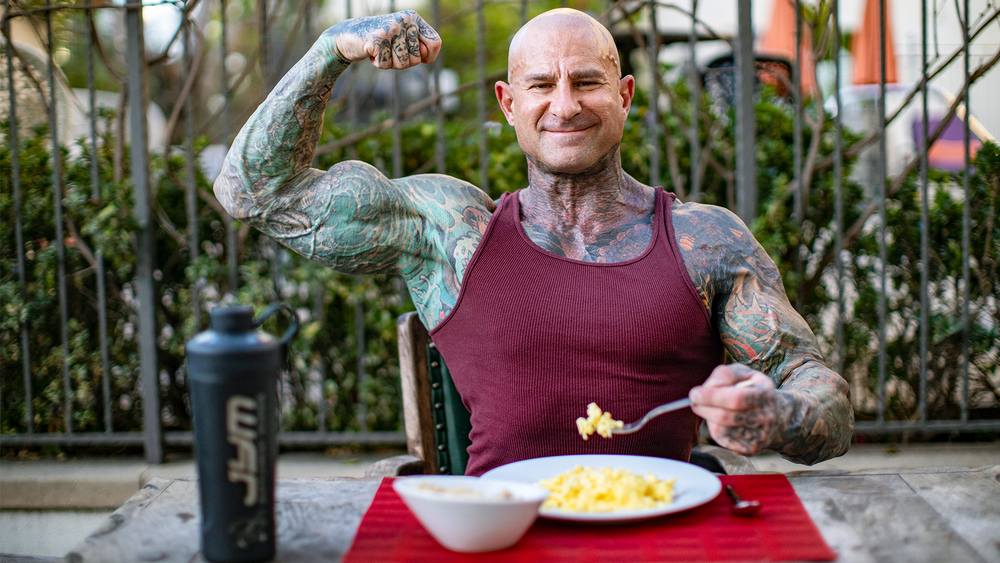Shortcut to Size Diet
Choose between two Shortcut to Size meal plans – one that maximizes mass and strength and the other that emphasizes leaning out.

Choose between two Shortcut to Size meal plans – one that maximizes mass and strength and the other that emphasizes leaning out.

No training program is complete without a nutrition and supplement regimen to work with it – this is especially true for a mass-gaining program. Training is just half the equation, and nutrition is equally, if not more important, for realizing your goals.
Just as you can alter your training to focus more on a specific goal, you also need to alter your diet to better reach that objective. Those of you who want to maximize strength gains and/or muscle mass during these 12 weeks should follow the Shortcut to Size Gain Size and Strength Diet. If you want to maximize fat loss while you still gain strength and muscle, then follow the Shortcut to Size Get Lean Diet.
If your primary goal is to gain more muscle mass and/or strength, this is the diet you’ll want to follow during the 12 weeks of Shortcut to Size. As you know, the three main macronutrients are: 1) Protein, 2) Carbs and 3) Fat. As you’ve heard me state time and again, protein is critical for building mass and maximizing strength level. So it should come as no surprise that this diet will provide you ample amounts of protein to pack on muscle and get you stronger and more powerful.
The basic Shortcut to Size diet template, which is meant for days you’re not training, will provide you about 1.5 grams of protein per pound of bodyweight daily. This will keep you anabolic and encourage muscle growth. On workout days, the addition of pre-workout and post-workout shakes will bring your total daily protein intake closer to 2 grams per pound. The extra protein will ensure that you’re really kicking up muscle growth on training days.
Carbs are the macronutrient we like to give the most credit to when it comes to providing us energy, especially when we train. Yet, while carbs are critical for workout energy, so is protein and fat. Yes, amino acids from the protein you eat can be used for energy, as can fat. I’ll get into this in just a minute.
But back to carbs. To ensure you have ample levels of energy to get through the Shortcut to Size workouts and recover properly, you’ll be getting in about 1.5 grams of carbs per pound of body weight on rest days and a full 2 grams of carbs per pound on workout days. To provide yourself long-lasting energy that will get you through these grueling workouts without adding body fat, you should focus mainly on slow-digesting carbs.
Research studies confirm that when athletes consume slow-digesting carbs like fruit and whole grains earlier in the day (ie, breakfast and lunch), they have more energy for workouts and can train harder for longer. In addition, they burn more fat during exercise as well as at rest. That is why the Shortcut to Size diet focuses on fruits, oatmeal and whole-wheat bread. These carbs will keep insulin levels low, which means you’ll have more stable and longer-lasting energy and you’ll burn more fat.
However, there’s a time or two when you want to focus on fast-digesting carbs. The first time is right when you wake up. Getting in fast carbs at this time will send those carbs straight to your liver, which will tell your body to stop burning up muscle protein for fuel. Unfortunately, when you sleep you go so long without eating that your body begins to feed on your muscle for fuel. Getting in fast carbs like cantaloupe (one of the few fast-digesting fruits, along with watermelon) will stop this undesirable process quickly.
Even other fruits that are low-glycemic or slow-digesting, such as apples, berries and oranges, make a good carb choice when you wake. One of the main reasons fruit is low glycemic is the fructose content. Fructose has to go to the liver first to be converted to glucose (blood sugar), thus making it “slow.” But the fructose still gets to your liver fairly quickly and signals your liver to stop burning
Related Articles